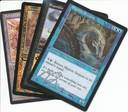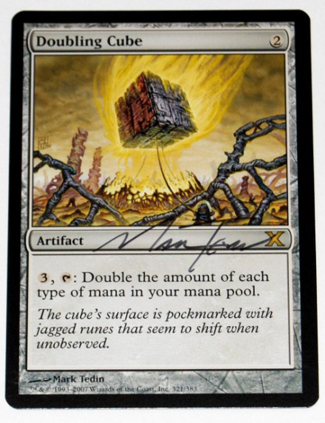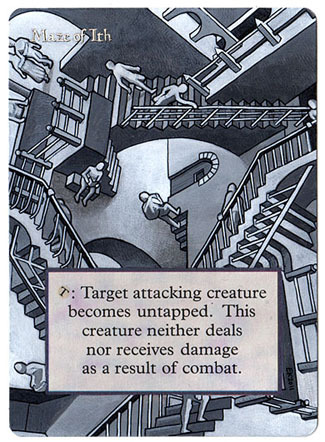As this goes live, I will be attending what is considered to be the best gaming convention of the year, Gen Con. For those of you who can’t make it, tune in next week as I give a summary of all of the major events and talk about the trade floor at an event that is not just for Magic. I will also link my podcast, Brainstorm Brewery, which will be doing a video blog off all the weekend’s events as well as some extracurriculars such as the Booze Cube. This week, I want to cover a topic I received through e-mail in regards to artist-signed and altered cards. This is a topic most people know something about but few have a lot of details on, so I want to shed some light—I am sure this particular reader is not the only one with these questions.
First, let’s get to the e-mail in question and break it down and approach it step by step. I will also be covering some things he did not mention in the e-mail but that I feel are particularly important in regards to this subject.
–Daniel
Signatures
 First, I want to say “thank you” to Dan for sending this in; I like to hear from the readers in regard to both topics and comments, so never hesitate to contact me. So, let’s approach this from the top down. The first order at hand is the topic of signed planeswalkers, which we can then expand to signed iconic cards. This category can range anywhere from Legacy staples to casual legends for Commander. In this case, we are talking about the core set planeswalkers, and he discusses how he managed to up-trade these cards—due to the signatures—for a healthy profit. I have encountered situations in the past in which this holds true, and although I do not put a premium on signed cards, I do try to trade them to the right crowd that can appreciate the signature, and in turn, I can typically get more in return for them. This is typically the casual crowd at local gaming stores or colleges that either do not or cannot travel to major events where these artists are regularly in attendance. If you find the right person, even the easiest to find signature such as RK Post or Rob Alexander can fetch you a decent return. This does not mean I would be rushing to the artist booth to get every card signed, but there is not harm in trying to out any of the ones you pick up in trades for a small premium if you have the opportunity. Typically, you want cards that see play in some format or are casual staples—no matter how rare the signature, no one wants a bulk rare signed by the artist if he or she is never going to play or display it.
First, I want to say “thank you” to Dan for sending this in; I like to hear from the readers in regard to both topics and comments, so never hesitate to contact me. So, let’s approach this from the top down. The first order at hand is the topic of signed planeswalkers, which we can then expand to signed iconic cards. This category can range anywhere from Legacy staples to casual legends for Commander. In this case, we are talking about the core set planeswalkers, and he discusses how he managed to up-trade these cards—due to the signatures—for a healthy profit. I have encountered situations in the past in which this holds true, and although I do not put a premium on signed cards, I do try to trade them to the right crowd that can appreciate the signature, and in turn, I can typically get more in return for them. This is typically the casual crowd at local gaming stores or colleges that either do not or cannot travel to major events where these artists are regularly in attendance. If you find the right person, even the easiest to find signature such as RK Post or Rob Alexander can fetch you a decent return. This does not mean I would be rushing to the artist booth to get every card signed, but there is not harm in trying to out any of the ones you pick up in trades for a small premium if you have the opportunity. Typically, you want cards that see play in some format or are casual staples—no matter how rare the signature, no one wants a bulk rare signed by the artist if he or she is never going to play or display it.
Next on the docket, we have the subject of hard-to-find artist such as the ones mentioned in the question above. When it comes to artist who either don’t make many appearances or else have ceased to do Magic-related work, it is all about finding the correct buyer. Many times, people in local areas cannot appreciate the difference between these artist and those such as RK Post who show up all the time, so it may be best to look for another outlet. In these situations, I would do some research and see just how rare it is to see that artist, and you can then put the word out through social media sites such as Twitter and Facebook that you are looking to unload said signed cards.
If you are looking for a value, on the other hand, that is much harder to determine since this is one of those cases that very heavily depends the buyer and how much value he or she puts on the signature. If the artist only makes an appearance once every few years, I would seek to double the card’s value, but I would be open to offers beyond the retail price and go from there. Someone may find that very reasonable and snap the cards up, but it is just as likely that the cards may sit for a few weeks until someone sees them. Unfortunately, signed cards have the same problem as alters, which I will cover in a minute, and that is that you are relying on the right crowd seeing the post. This market is very limited when it comes to hard-to-find signatures, so just give it some time and make sure you let everyone see what you have before you commit to a sale.
Alters
 Now that we have covered the questions Daniel—and I am sure many others of you—may have had, I want to talk a little more about artists before I depart this week. The last topic I want to cover is artist alters, both from the actual artist and outside sources. This is a topic I have touched on before, but I want to go into a little more detail on the subject since this week is all about the artists who have designed and depicted the beautiful world of Magic: The Gathering.
Now that we have covered the questions Daniel—and I am sure many others of you—may have had, I want to talk a little more about artists before I depart this week. The last topic I want to cover is artist alters, both from the actual artist and outside sources. This is a topic I have touched on before, but I want to go into a little more detail on the subject since this week is all about the artists who have designed and depicted the beautiful world of Magic: The Gathering.
First, let’s cover art additions by the actual artist and how you should value them compared to a regular mint version of the card. Some people love alters and put a huge premium on them, but in my experience, it is very hard to move alters unless you know or manage to find that person. The same rule also applies here that also applies for signatures: An alter is worth more on average if it is done by an artist who does not necessarily attend a large number of events because it’s more likely to be unique. Some artists have typical pictures they will draw on particular cards, and although it may look very cool, it is not likely to demand a huge premium if you see those same alters floating around in multiple binders.
The quality of the alter is also very important here; since most alters are done with a sharpie and take under five minutes, they are less likely to fetch much. If you can get an artist to do an acrylic alter or otherwise paint-based medium, you will probably have an easier time moving the card. Ideally, I try to only pick up alters that have both time and effort put into them because they are nice to showcase in your binder and set you aside from the next guy. This does not mean I won’t pick up simple alters, but I usually won’t put any premium on them unless the artist is not someone who typically does alters.

Maze of Ith by Eric Klug
The next and final type of alter I want to cover this week is the type of alters done by outside sources, such as Cardkitty and Eric Klug, to name a few of the more popular ones. These alters typically have a lot of time and effort put into them and tend to be one-of-a-kind, so showcasing and unloading them is a far easier task. Picking up alters from less known artist can still turn a profit if done well, but people like to know who did the alter, and being able to put a well-known name behind a card allows you to ask for a more significant premium. If you can score any of these well-known alters for cheap, you should, but most people who have these are not willing to come off them without a very good price—they usually cost upward of $30 to $50 to have done in the first place. Less-known artist can still fetch a hefty dollar, but they are usually lighter on the wallet on the way in, and therefore, they probably have better margins if you have an outlet. The only alters I won’t usually touch at all are the printed ones done en masse, as they can typically be found all over the Internet, and although they may look awesome, they don’t usually fetch much if any premium since they are so common.
And That’s It
That’s all I have for this week; stay tuned for the next article in which I will discuss all the Gen Con antics and tales that can only happen once a year. The main lesson I hope everyone walks away from this week is to be sure to do your research before you pick up alters and signatures. Most people won’t be looking to pick these up for much if any premium, but if you can find the right outlet, they can net you a healthy chunk of change for your time. Artists put in a lot of time and effort making the world of Magic come to life, so next time you are playing a game, take a second look at some of the cards—you may be amazed at some of the detail you may have missed at first glance!
Ryan Bushard
























